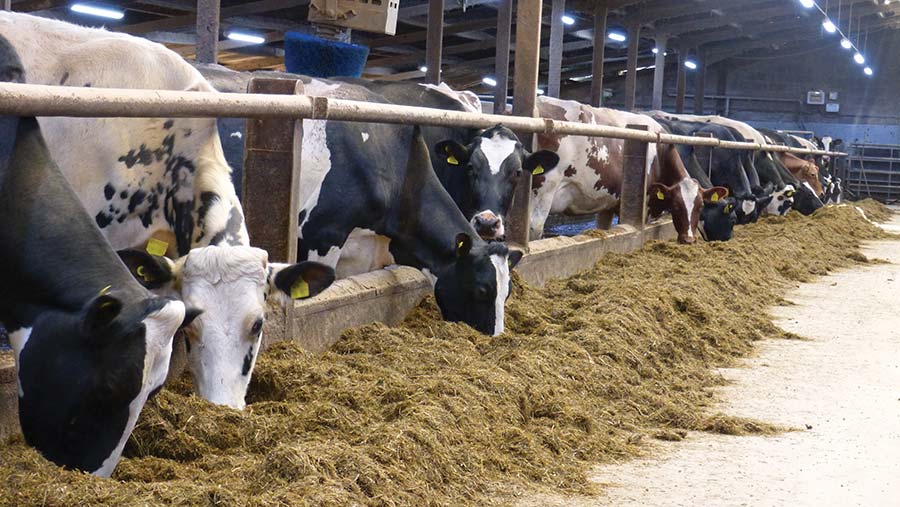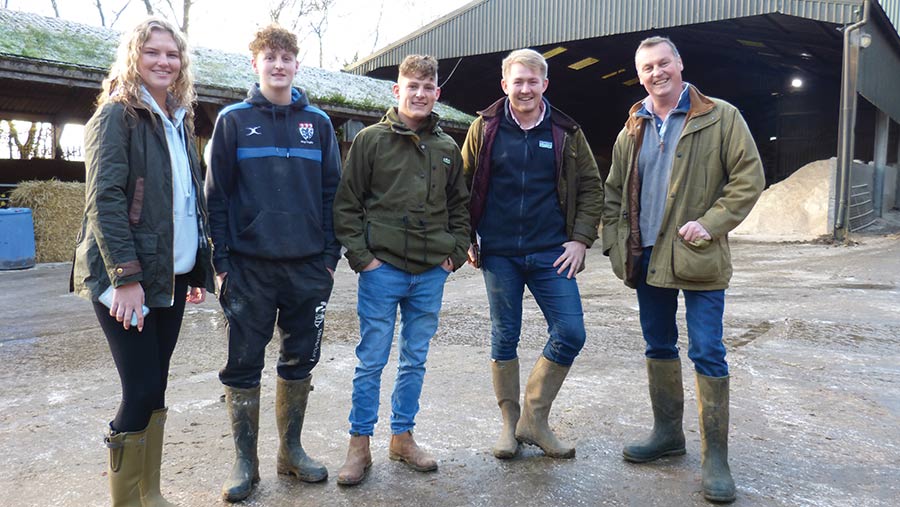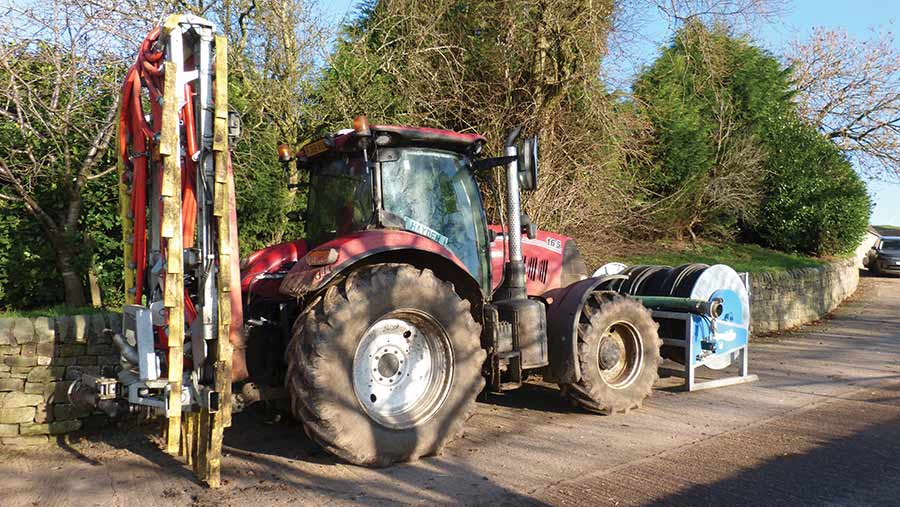Calving dairy improves water management with funding grants
 ©MAG/Michael Priestley
©MAG/Michael Priestley Cherry-picking options from three funding streams has helped a year-round calving dairy make targeted investments to improve water management in a critical catchment area.
The Heaths at Red Earth Farm, Rudyard, near Leek, have used funding from Defra, Natural England and Severn Trent Water to modernise their 600-cow unit.
Stuart Heath and sons Hayden and Sam say that a good understanding with water quality advisers has made working with the local water authority helpful, rather than restrictive.
“We have focused on clean yards, soil health, nutrient management and sward quality,” explains Stuart.
“We’ve worked closely with Severn Trent Water for 15 years. Our farming system has improved on the back of investing in water quality.”
See also: How water treatment tech could cut dairy slurry storage
Farm facts: Red Earth Farm, Staffordshire
- 300ha, split across three main neighbouring farms
- Tesco Sustainable Dairy Group supplier
- 9,500 litres a cow a year average
- Rear 50 replacements a year and buy the remainder
- Calves sold into integrated dairy beef schemes
- 75kW biomass boiler
- 80kW wind turbine
- 50kW solar array
- 12 full-time staff
Farm setup
Stuart’s parents, Jim and Gill, bought Red Earth Farm – a productive 80ha (198-acre) dairy farm – in 1969. The yard lies before a sharp climb up Gun Hill, and the top of the farm rises to 325m.
Neighbouring farm The Fould, which has six commercial business lets, was bought in 1978, adding 50ha (124 acres). A third adjacent farm, Lower Foker (32ha (79 acres)) was rented in 2017. They all share one diet feeder.
Other land parcels purchased from neighbouring farms take the ring-fenced area up to about 300ha (741 acres). Cows are shared across three sites, and a seven-cow trailer transfers cows between the dairy units.

Daisy Peacock, Sam and Hayden Heath, Josh Ballance and Stuart Heath © MAG/Michael Priestley
Red Earth houses transition cows, fresh cows, later-lactation milkers on summer grazing, and some high yielders. The Fould houses heifers while Lower Foker houses higher yielders.
This poses logistical challenges, but has the benefit of giving each farm a focus, and they function well despite sheds and slurry stores approaching 40 years of age.
Management skills are required on each site, allowing staff more scope for career progression.
Soil type is hugely variable, from clay loams in the Churnet valley, through sandy-clay loams and free-draining sand, up to stonier clay and peaty ground on the hilltop.
Annual rainfall is 1,000mm and six watercourses run through the farm.
Each farm has a slurry tower, and Red Earth Farm pumps from its tower to a 2m gallon lagoon higher up Gun Hill, about 1.6km away. Pumping five times a year means the farm has six months’ storage.
In summer, the Heaths do four or five silage cuts with their own machinery, applying 22.4-28cu m/ha of slurry to silage fields after at least three cuts.
Advice on water quality
Because the farm affects the Wallmyres, Highgate and Poolend catchment area (groundwater) and Tittesworth reservoir (surface water), the farm can access funding through the Severn Trent Environmental Protection Scheme (Steps) to safeguard water quality.
The Heaths’ water quality adviser is Josh Ballance of the Trent Rivers Trust. His role includes advising on Countryside Stewardship and Steps funding, which is provided free of charge.
Josh conducts monthly water quality tests for pesticides, nitrates, phosphates, and other contaminants, such as cryptosporidium, near the Heaths’ farm, to check the systems put in place to protect water quality are working.
“Having a knowledgeable and enthusiastic adviser is important,” says Stuart. “Recently, we have gone down the Countryside Stewardship route more, but for some options it helps if Josh endorses us.”
Farmers Weekly asked the Heaths which areas they have focused on.
Concreting
Improvements Some high-traffic/high-risk areas have been concreted at Red Earth, Fould and Lower Foker. One area is between the cow shed and the feed store/silage clamp.
Another is around the slurry tower, which is bunded so that in the case of a spillage, effluent goes to a grass field, rather than entering a watercourse.
Positives Stuart sees concreting as something that gives a return on investment, and is the easiest way to keep the farm and watercourses clean.
Funding 50%, up to a limit of £10,000, through Steps.
Comments All options to concrete more of the farm will be looked at across Defra, Countryside Stewardship and Steps.
Water troughs and fencing
Improvements A project to pump water from a borehole at 152m above sea level to land at 310m, supplying 60ha (148 acres) of grazing – now split into 21 paddocks – has used 3km of piping.
Water held in three 10,000-litre tanks at the top of the farmyard is pumped to a 2,000-litre tank in a wood at the top of the hill, feeding into 12 concrete troughs.
Positives This means cows can be on daily or 12-hour shifts with electric fencing in peak grass growing season. The tanks have increased waterflow rate during dry weather.
Funding Steps has funded 50% of fencing costs and 100% in cryptosporidium-risk areas. The project to get more water to the top of the hill cost £15,000, and the cost of the troughs and pipe (£2/m) was covered by Steps.
Comments Low yielders (with no buffer feeding), dry cows and youngstock, as well as wintering sheep, graze the hill.
Changing environment and diet probably costs 500 litres in production, but this is clawed back in savings on housing and feeding costs. More troughs will be put in to improve water provision on this grazing block.

© MAG/MIchael Priestley
Precision spreading
Changes By using GPS mapping and chemical and physical soil assessments, the farm’s umbilical kit, with dribble bar and flow meter, can accurately apply slurry to specific fields.
Positives Slurry and farmyard manure is targeted at areas with lower soil indices. The umbilical kit reaches every field. Phosphate and potassium are no longer bought in.
Funding The Heaths used Steps funding to buy an umbilical kit, flow meter and a dribble bar in 2013. These have since been updated with money from the Farming Equipment and Technology Fund.
Countryside Stewardship has subsidised some soil testing work, and the Steps innovation option helped fund a sward lifter.
Comments Improving the accuracy of spreading slurry and aerating the soil means it gets what it needs and better structure.
Hayden has worked hard to maximise use of the improved kit and apply slurry straight after cutting.
The next step is to install ring main piping so more slurry can be pumped underground. Refitting a damaged slurry store cover will reduce slurry quantity dramatically.
Herbal leys
Improvements A total of 30ha (74 acres) of herbal leys has been direct-drilled to rejuvenate outlying silaging and grazing fields since 2020.
Positives Silage production is 20-30% less from these leys, but 180-200kg N/ha is being saved. Rooting structures are deeper than conventional ryegrass, and the increased biodiversity is helping pollinators.
Funding Steps is funding the herbal ley transitions at £382/ha. Sustainable Farming Incentive will be used elsewhere in the future.
Comments More herbal leys will be put in, subject to funding.
